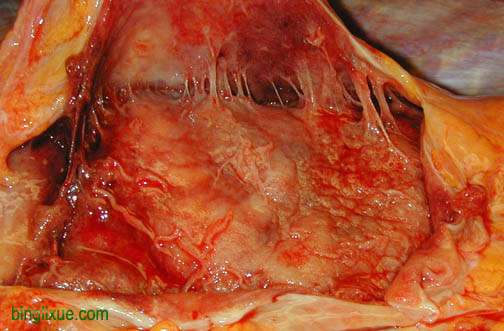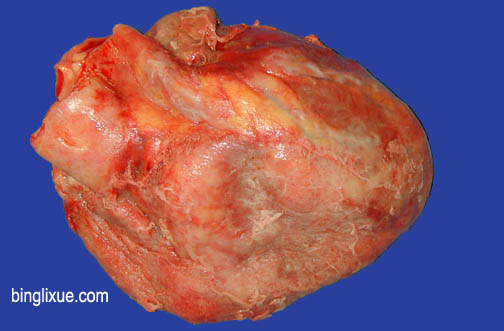


病毒感染引起的心包炎。上图为剖开的心脏,可见心外膜和心包膜间的纤维素性粘连性病变,也可见大量的小出血点。下图可见粗大的纤维素性绒毛。自身免疫性疾病或病毒感染时易发生浆液性心包炎,有一定程度的炎症反应,但很少有渗出。心肌梗死时纤维素性心包炎局限于梗死区附近,然而尿毒症时心包炎病变较为广泛。纤维素渗出可能出现于自身免疫性疾病和感染性疾病。转移瘤和结核最有可能引起广泛出血,常分布于纤维素渗出物上方。化脓性心包炎常由肺或纵隔的细菌感染播散引起。心包炎痊愈后经常导致局限性的粘连,但有时(结核性心包炎)愈合后广泛性粘连导致缩窄性心包炎。
The pericardial cavity has been opened to reveal fibrinous adhesions between epicardium and pericardium in the top panel. There is also a small amount of reddish discoloration from hemorrhage. The shaggy fibrin is seen over the anterior surface of the heart in the lower panel. This is pericarditis. The etiology in this case was infectious (viral). A serous pericarditis, in which there is some inflammation but little or no exudation, is most often due to autoimmune diseases or viral infection. A fibrinous pericarditis can be localized over an area of myocardial infarctiion and more extensive when uremia is present. Fibrinous exudate may be present with infections and autoimmune diseases. Metastatic tumor and tuberculosis are most likely to produce extensive hemorrhage, often superimposed upon a fibrinous exudate. A purulent pericarditis is most often the result of spread of bacterial infection from lung or mediastinum. Healing of pericarditis most often results in focal adhesions, but occasionally (and particularly with tuberculous pericarditis) healing leads to extensie scarring that encases the heart ('constrictive pericarditis').